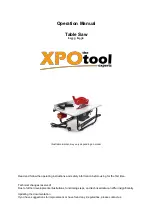
www.scheppach.com /
+(49)-08223-4002-99 /
+(49)-08223-4002-58
GB | 25
5. Do not mix old and new batteries or batteries
of different types or manufacturers! Replace an
entire set of batteries at the same time.
6. Immediately remove used batteries from the
device and dispose of them properly! Do not
dispose batteries with household waste. Defective
or used batteries must be recycled according to
Directive 2006/66 / EC. Give back batteries and
/ or the device has been offered to the collective
facilities. About disposal facilities you can inform
by your municipal or city government.
7. Do not allow batteries to heat up!
8. Do not weld or solder directly on batteries!
9. Do not dismantle batteries!
10. Do not allow batteries to deform!
11.
Do not throw batteries into fire!
12. Keep batteries out of the reach of children.
13. Do not allow children to replace batteries without
supervision!
14.
Do not keep batteries near fire, ovens or other
sources of heat. Do not use batteries in direct
sunlight or store them in vehicles in hot weather.
15. Keep unused batteries in the original packaging
and keep them away from metal objects. Do not
mix unpacked batteries or toss them together!
This can lead to a short-circuit of the battery and
thus damage, burns or even the risk of fire.
16. Remove batteries from the equipment when it will
not be used for an extended period of time, unless
it is for emergencies!
17. NEVER handle batteries that have leaked
without appropriate protection. If the leaked
fluid comes into contact with your skin, the skin
in this area should be rinsed off under running
water immediately. Always prevent the fluid from
coming into contact with the eyes and mouth.
In the event of contact, please seek immediate
medical attention.
18. Clean the battery contacts and corresponding
contacts in the device prior to inserting the
batteries.
7. Residual risks
The machine has been built according to the
state of the art and the recognised technical
safety requirements. However, individual residu-
al risks can arise during operation.
• Health hazard due to electrical power, with the use
of improper electrical connection cables.
• Furthermore, despite all precautions having been
met, some non-obvious residual risks may still re-
main.
• Residual risks can be minimised if the „safety in
-
structions“ and the „Proper use“ are observed
along with the whole of the operating instructions.
6. Do not use any loose reducing rings or bushes for
the reducing of holes on saw blades.
7.
Make sure that fixed reducer rings for securing
the insertion tool have the same diameter and
have at least 1/3 of the cutting diameter.
8.
Make sure that fixed reducer rings are parallel to
each other.
9. Handle insertion tool with caution. They are
ideally stored in the originally package or special
containers. Wear protective gloves in order to
improve grip and to further reduce the risk of
injury.
10. Prior to the use of insertion tools, make sure that
all protective devices are properly fastened.
11. Prior to use, make sure that the insertion tool
meets the technical requirements of this electric
tool and is properly fastened.
12. Only use the supplied saw blade for cutting wood,
never for the processing of metals.
Attention: Laser radia
tion
Do not stare into the beam
Class 2 laser
Protect yourself and you environment from ac-
cidents using suitable precautionary measures!
• Do not look directly into the laser beam with un
-
protected eyes.
• Never look into the path of the beam.
•
Never point the laser beam towards reflecting sur-
faces and persons or animals. Even a laser beam
with a low output can cause damage to the eyes.
•
Caution - methods other than those specified here
can result in dangerous radiation exposure.
• Never open the laser module. Unexpected expo
-
sure to the beam can occur.
• If the mitre saw is not used for an extended period
of time, the batteries should be removed.
• The laser may not be replaced with a different type
of laser.
• Repairs of the laser may only be carried out by the
laser manufacturer or an authorised representa
-
tive.
Safety instructions for handling batteries
1. Always make sure that the batteries are inserted
with the correct polarity (+ and –), as indicated on
the battery.
2.
Do not short-circuit batteries.
3.
Do not charge non-rechargeable batteries.
4. Do not overcharge batteries!
Содержание 3901105941
Страница 18: ...www scheppach com service scheppach com 49 08223 4002 99 49 08223 4002 58 18 DE...
Страница 222: ...www scheppach com service scheppach com 49 08223 4002 99 49 08223 4002 58 222 NL...
Страница 223: ...www scheppach com service scheppach com 49 08223 4002 99 49 08223 4002 58 223...
Страница 224: ...www scheppach com service scheppach com 49 08223 4002 99 49 08223 4002 58 224...
Страница 226: ...www scheppach com service scheppach com 49 08223 4002 99 49 08223 4002 58...
















































